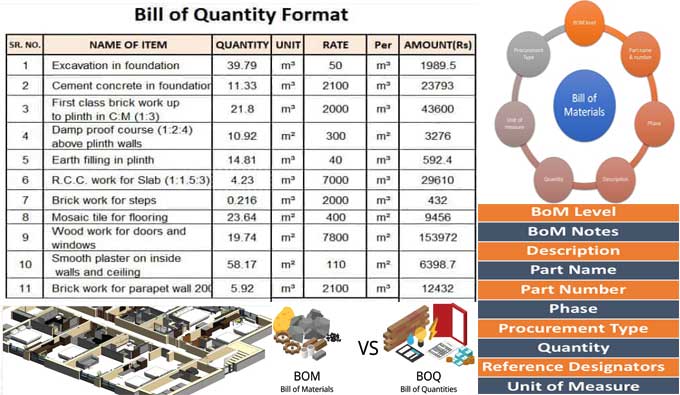
What do you mean by Bill of Quantity (BOQ) and Bill of Material (BOM)?
What is the Bill of Quantity (BOQ)?
The Bill of Quantity (BOQ) is a document prepared by a quantity surveyor or estimator that itemizes all the materials, parts, and labour required for a construction project or any other type of project. It contains a detailed list of quantities and descriptions of items, as well as the rates and costs for each item.
The BOQ provides a clear and concise breakdown of the work required to complete the project, which helps to ensure that all parties involved are aware of the scope of the work and the cost of each component. The BOQ is an essential tool for contractors, architects, engineers, and clients to understand the financial implications of the project and to allocate resources effectively.
What is the Bill of Material (BOM)?
The Bill of Materials (BOM) is a comprehensive listing of all the parts, components, raw materials, subassemblies, and assemblies needed to make a product. It contains detailed information about each item, including its part number, description, quantity, and unit of measure.
The BOM is an essential document in the manufacturing process as it serves as a blueprint for the production team, helping them to procure the necessary materials, manage inventory, and assemble the product correctly. It is also used for estimating the cost of the product, planning production schedules, and ensuring quality control.
The BOM can be structured in a hierarchical manner, with the final product at the top and the various subassemblies and components listed beneath it. Each level of the BOM is called a level or indenture, and it provides a detailed breakdown of the product's composition
How does BIM help in improving the Bill of Quantity (BOQ) and the Bill of Material (BOM) process?
For design, construction, and maintenance purposes, Building Information Modeling (BIM) illustrates the physical and functional characteristics of a building digitally. BIM can improve the accuracy and efficiency of both the Bill of Quantities (BOQ) and Bill of Materials (BOM) by providing a more detailed and comprehensive data set.
BOQ and BOM are used in construction projects to provide detailed information on the quantities and types of materials required to complete a project. They are critical to the success of a project, as they help to ensure that the right materials are procured at the right time, and in the right quantities.
BIM improves BOQ and BOM by providing a more detailed and accurate representation of the building design. This means that the quantity and type of materials required can be more accurately estimated, reducing the risk of over or under-ordering of materials. BIM can also help to identify potential clashes or conflicts between different components, which can be resolved before construction begins.
In addition, BIM can facilitate collaboration between different stakeholders involved in a project, such as architects, engineers, and contractors. This can help to ensure that everyone is working from the same information and can make more informed decisions throughout the project lifecycle.
BIM can improve the accuracy and efficiency of BOQ and BOM, reducing the risk of errors and delays, and helping to ensure that construction projects are completed on time and within budget.
How does Revit help in improving the Bill of Quantity (BOQ) and the Bill of Material (BOM) process?
Revit is building information modelling (BIM) software that is designed to help architects, engineers, and construction professionals create detailed 3D models of buildings and structures. These models can be used to improve the accuracy and efficiency of the Bill of Quantity (BOQ) and Bill of Material (BOM) process in several ways:
Automatic Quantity Takeoffs: Revit enables automatic quantity takeoffs from the 3D models created in the software. This feature eliminates the need for manual calculations, thereby reducing the chances of errors and improving the accuracy of the BOQ.
Real-time Updates: Any changes made to the 3D model in Revit are reflected in the BOQ in real time. This ensures that the BOQ is always up-to-date and accurate.
Material Scheduling: Revit allows for the creation of detailed material schedules for all the components used in the building or structure. This feature enables the accurate tracking of materials, quantities, and costs, which can help in the creation of an accurate BOM.
Integration with Cost Estimation Software: Revit can be integrated with cost estimation software, such as Primavera or MS Project, to further improve the accuracy of the BOQ and BOM process. This integration allows for a more detailed and accurate cost estimate, which can help in project planning and management.
Revit can significantly improve the BOQ and BOM process by enabling accurate quantity takeoffs, real-time updates, detailed material scheduling, and integration with cost estimation software
What are the differences between Bill of Quantity (BOQ) and Bill of Material (BOM)?
There are some differences between Bill of Quantity (BOQ) and Bill of Material (BOM), they are as follows:
Bill of Quantity (BOQ):
- Used in construction projects.
- Lists all items and quantities required to complete the project.
- Provides a detailed description of each item and materials required.
- Organized by trade or work package.
- Used to help contractors and suppliers prepare accurate project bids.
To get more details, watch the following video tutorial.
Video Source: Engineering Academy
Bill of Material (BOM):
- Used in manufacturing projects.
- Lists all materials, components, and sub-assemblies required to make a product.
- Provides a detailed description of each item, including manufacturer, part number, and unit cost.
- Organized by product or assembly, with different levels representing different levels of product hierarchy and importance.
- Used to ensure necessary materials are available, track inventory levels, and monitor costs.


